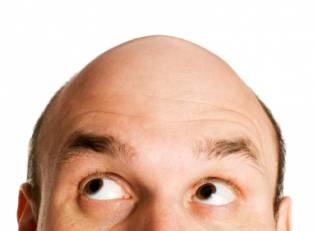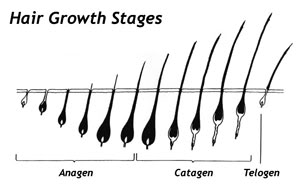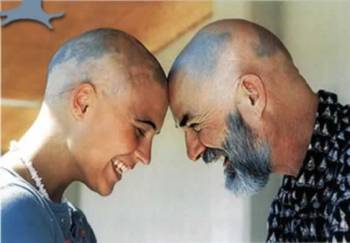Male Pattern Hair Loss
 Male pattern hair loss is the most common type of hair loss. It is a genetic condition with no known cure, and it is caused by a genetic increased sensitivity to androgens (male sex hormones) in the scalp, resulting in the gradual thinning and loss of hair.
Male pattern hair loss is the most common type of hair loss. It is a genetic condition with no known cure, and it is caused by a genetic increased sensitivity to androgens (male sex hormones) in the scalp, resulting in the gradual thinning and loss of hair.
This condition typically begins in men aged 20 to 30, and follows a typical pattern of hair loss. It is generally characterized by a receding hairline and thinning crown.
Whilst some men may be proud of their "shiny scalps", most are actually unhappy with the situation and would do anything to change it. Hair loss, to some, can potentially affect self esteem and interpersonal relationships.
NORMAL HAIR GROWTH
There are 3 stages in a hair's growth cycle.
1. Anagen Stage (Growth Phase)
This is the “growing” phase in which new hairs grow out from the hair follicles. This phase usually lasts from about 2 to 3 years (occasionally much longer).
2. Catagen Stage (Regression Phase)
During this stage, the hair stops growing and the hair follicle shrinks. As the lower part of the hair follicle disintegrates, the hair moves upward in the hair follicle, away from the root and blood vessels. The regressed hair follicles have a looser “grip” on the hair shafts during this phase, and normal combing and bathing may result in the hair shaft being shed. This phase lasts about 2 to 3 weeks.
3. Telogen Stage (Resting Phase)
This stage lasts about 3 months. The matured hairs now have short, club-shaped roots, which are loosely anchored to the follicle. The hairs continue in this resting state until the follicle spontaneously reenters the anagen phase again. At this point, the club hairs are forced out by the new growing hairs underneath, and a new cycle begins.

The thousands of hair follicles in the scalp are in different phases. The majority however, are in the anagen stage, with about 10 – 15% in the catagen or telogen phase at any one time. Each hair follicle has its own life cycle that can be influenced by age, disease, and a wide variety of other factors.
WHAT CAUSES IT?
The enzyme 5 alpha reductase converts testosterone into dihydrotestosterone (DHT).
Exposure of hair follicles to DHT causes them to shrink, and when DHT is suppressed, hair follicles continue to thrive. In male pattern hair loss, there is an inherited sensitivity to DHT. These DHT sensitive hair follicles, on continuied exposure to DHT, begin to miniaturize, shortening their lifespan and resulting in hair loss.
Hair follicles in the sides and front of the scalp appear to be most sensitive to DHT, thus resulting in the typical pattern of male pattern baldness observed.
CONDITIONS WHICH CAN CAUSE HAIR LOSS
It is normal for the average person to lose up to 100 strands of hair each day through normal combing, brushing or washing of hair. Excessive hair loss, however, may indicate some underlying condition.
A number of conditions are known to cause hair loss. The more common conditions are listed below:
• Alopecia Areata
• Pregnancy and childbirth
• Hyperthyroidism and hypothyroidism
• Other hormonal problems
• Severe stress
• Major surgery
• Major infections or illness
• Autoimmune diseases, such as systemic lupus
• Fungal infections of the scalp
• Excessive pulling of hair - psychological or wearing of tight ponytails etc.
• Medication
MEDICATION WHICH CAN CAUSE HAIR LOSS
Many drugs can potentially cause hair loss. With some, the hair loss may be minimal, whilst with others, there may be total hair loss (eg with chemotherapy drugs). The good news is that, in most cases of drug-induced hair loss, it is reversible once the offending drug is stopped.
Drugs cause hair loss by affecting their normal growth cycle.
2 types of hair loss are recognisable:
1. Telogen effluvium
The offending drug causes the hair follicles to go into their telogen ("resting") phase and fall out too early. This usually appears within 2 to 4 months after starting the drug. This is a more common type of drug-induced hair loss.
2. Anagen effluvium
The offending drug prevents normal cell division (required for growth). The matrix cells which are responsible for hair growth are also prevented from dividing normally. This type of hair loss occurs during the anagen ("growth") phase of the hair cycle, and the hair loss is experienced usually within a few days to weeks after starting the medication. Chemotherapy drugs are well known to cause this type of severe hair loss, occurring in the scalp, eyebrows, eyelashes and other parts of the body.
Drugs Which Can Cause Hair Loss (not an exhaustive list)
 • Oral contraceptives
• Oral contraceptives
• Retinoids (acne medication)
• Antibiotics and antifungals
• Steroids
• Thyroid medication
• Cholesterol-lowering drugs
• Psychiatric drugs eg. antidepressants, mood stabilizers
• Epilepsy drugs
• Hypertension medication eg. beta-blockers, ACE inhibitors, diuretics
• NSAIDS (non-steroidal anti-inflammatory drugs)
• Medication used to treat Parkinson's Disease
• Weight loss medication
• Drugs that suppress the immune system
• Chemotherapy drugs
You should consult your doctor if you suspect that your hair-loss may be due to some medication you may be taking.
TREATMENT OF MALE PATTERN HAIR LOSS
Minoxidil
Minoxidil, a vasodilator, was initially used as an oral medication for the treatment of hypertension. It was found, however, to have the side effect of hair growth. Subsequent approval was given for it to be used as a topical solution to treat baldness. Minoxidil is marketed under the brands Rogaine (in the US), and Regaine (outside the US), and is available in 2% and 5% solutions.
The mechanism of action is believed to be related to its vasodilator effect, causing opening up of the blood vessels in the scalp, thus allowing more oxygen, blood and nutrients to the hair follicles, promoting hair growth. Minoxidil needs to be applied regularly for hair gain to be maintained.
Finasteride
Finasteride is marketed under the brand Propecia. It is an oral, once a day medication, which works by inhibiting 5 alpha reductase, the enzyme responsible for the conversion of testosterone to dihydrotestosterone (DHT). The hair follicles which are then exposed to lower levels of DHT can enlarge back to normal, thereby increasing hair growth.
Propecia is for treatment of male pattern hair loss in MEN ONLY.
Hair Transplantation
This consists of removing tiny plugs of hair from areas where hair is continuing to grow, and transplanting them onto areas that are balding. Usually, multiple transplantation sessions are required.
Wigs / Hair Pieces
Hair pieces have been around for a very long time. Over the years, the quality and variety of hair pieces available have greatly improved. They are made from mesh fabric, polymers or from real hair.
PSYCHOLOGICAL EFFECTS OF HAIR LOSS
 Losing one's hair can be a difficult thing to accept. Psychological problems due to hair loss, if present, tend to be most severe at the onset of symptoms. Women, in general, tend to suffer more emotionally and psychologically than men on losing their hair.
Losing one's hair can be a difficult thing to accept. Psychological problems due to hair loss, if present, tend to be most severe at the onset of symptoms. Women, in general, tend to suffer more emotionally and psychologically than men on losing their hair.
In men who start to bald early in life or in middle age, it may be seen as a sign of aging or loss of virility. There may also be the fear that they may not be as attractive to women anymore. Some men, however, may in fact, feel proud of their baldness, feeling an association with famous personalities such as Sean Connery, Yul Brynner and Bruce Willis.
In women, hair loss can be much more emotionally distressing. Many tend to judge their physical attractiveness and sexual appeal by their outward appearance. Society also tends to be much more accepting of a balding man, as there are numerous male celebrities who sport a bald head. In contrast, there tends to be a general lack of female role models who are bald.
Different people cope differently with hair loss. Some may not like it, but are otherwise not too concerned about it and take it as a normal part of life. Others are concerned enough to want to do something about it. Still others take it as a loss of self image and can react very badly to it, feeling distressed and unattractive. There may be loss of self esteem and well as depression in more severe cases.
It is important to recognize your true feelings towards hair loss. Seek treatment or counseling early.
The article above is meant to provide general information and does not replace a doctor's consultation.
Please see your doctor for professional advice.
